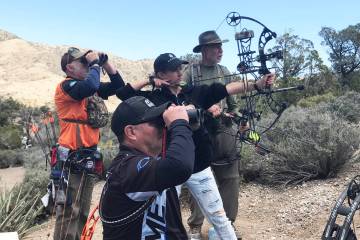Respect for public lands will keep them open
For lovers of the outdoors, one of the greatest things about living in the American West is the vast amount of publicly owned land that is available to us. This is especially true in Nevada where about 85 percent of all land belongs to you and me.
While some of that land is off limits to the general public because it has been set aside for military uses, most of it remains available to public access. Something that isn’t true in much of the United States, especially in states along the west coast and east of the Rocky Mountains.
For those of us who grew up wandering the West’s open spaces, it can be a little disconcerting to travel through parts of the country where much of what you see is locked behind a gate. It is kind of like walking through a museum where everything is behind a glass barrier. You can look but don’t touch.
There is a sense of freedom that comes from having access to public lands. They are places where one can explore and interact with nature on a variety of levels. For those who enjoy more regulated experiences and prefer getting their drinking water from a tap, there are national or state parks and formal campgrounds. While those who prefer to experience the outdoors in a less structured environment, and don’t mind filtering their drinking water, can enjoy a more primitive experience in informal settings.
Whatever your pleasure, access to our public lands comes with personal responsibilities. Among those are being a wise steward of the resource and making sure our impacts on the landscape and other users are minimal. With a population that has nearly doubled since 1960 and is now nearing 330 million, we can’t overlook these responsibilities.
Consider, for example, the impact residents of Las Vegas Valley will have on natural resources within a 3- to 4-hour drive in all directions over the Independence Day weekend. By the time the weekend is over, thousands of us will have escaped to outdoor destinations in Utah, Arizona, California and right here in the Silver State, all at the same time.
One of the biggest concerns for public lands this time of year is fire, and this year fire danger is especially high. The wet winter we had resulted in significant spring vegetation growth. Unfortunately, that vegetation becomes a fuel load as temperatures increase and it dries out.
To help prevent wildland fires, federal land managing agencies and fire departments have implemented seasonal fire restrictions that went into effect July 1. One of those is a prohibition on the use of fireworks on public lands, which makes sense because the fire risk is so high. For obvious reasons, this prohibition extends to the use of tracer rounds by recreational target shooters.
Other fire restrictions include the building and use of campfires and charcoal stoves, welding, using a cutting torch, or operating an off-highway vehicle without a spark arrestor. Portable stoves that use gas, jellied petroleum or pressurized liquid fuel are okay to use so long as the stove has an off/on switch.
There are some agency specific restrictions and exceptions you should be aware of, and they can be found online at www.nevadafireinfo.org .. The Bureau of Land Management, for instance, prohibits the use of steel core ammunition and exploding targets. Both have been identified as fire starters by the BLM.
Another area of concern is the stuff we bring with us into the wild. Apart from formal campgrounds and other recreational facilities, there are no garbage cans nor trash removal services in the wild. That is why you will see signs that remind us to pack out what we pack in. This principle applies whether we carry supplies on our backs or in a vehicle.
Contrary to what some people seem to believe, putting your trash in a plastic bag and leaving it under a tree, in your camp or alongside the road doesn’t count. Not only is trash unsightly, but it is dangerous to wildlife. In some places where backcountry use is heavy, you will find a dump site on the way out.
The American outdoors is a wonderful place with much to offer each one of us. There isn’t a better place to celebrate our Independence Day. All I ask is that we treat her with a little respect.
Freelance writer Doug Nielsen is a conservation educator for the Nevada Department of Wildlife. His “In the Outdoors” column, published Thursday, is not affiliated with or endorsed by the NDOW. Any opinions he states in his column are his own. Find him on Facebook at @dougwritesoutdoors. He can be reached at intheoutdoorslv@gmail.com

















